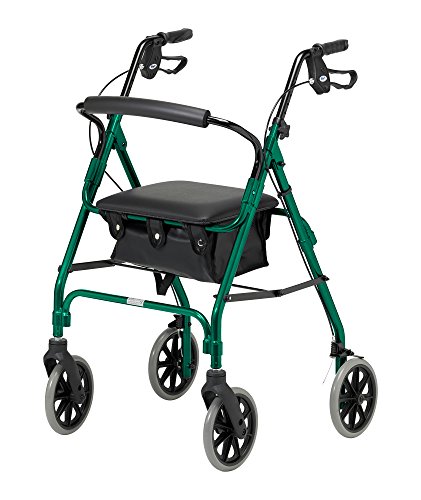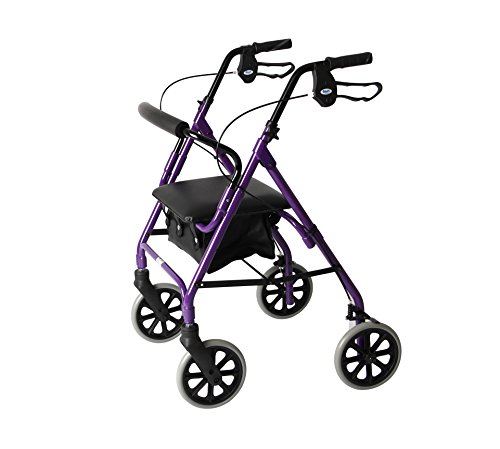What Is Rollator Mobility Walker? History Of Rollator Mobility Walker …
페이지 정보
작성자 Athena 작성일24-12-14 08:05 조회8회 댓글0건관련링크
본문
 Rollator Mobility Walker
Rollator Mobility Walker Rollators are a great option for people who have mobility issues and require stability while walking. They come with big wheels that have a space built into the frame for a seat.
Rollators are a great option for people who have mobility issues and require stability while walking. They come with big wheels that have a space built into the frame for a seat.This model has padded handles that create the feeling of comfort and ease pressure on the hands. It has height-adjustable handles and intuitive loop locks to prevent the walker moving when you're resting or sitting.
Comfort
If someone has suffered an injury that affects their balance and gait or recovering from knee, hip or other lower-limb surgeries or injuries, the rollator mobility walker could aid. These walking aids offer stability and support, allowing users to move more comfortably and stay active with their family and friends as well as the community.
They come in a variety of forms, including a traditional walker, which has no wheels and is simpler than rolling. Walkers typically have handles that are placed at a height that is comfortable for the user, making them ideal for those who needs stable support but still is able to move forward more easily than with a cane.
The wheels on a walker that roll make it more flexible and easier to use than a standard walking device. The wheels on a rollator are more to each other, making it easier to move and guide the device when in tight areas. They can also be swiveled to increase the speed of walking up and down stairs. Many rollators come with a seat and crossbar to provide users with a place to rest when they require.
Handles for rollators can be constructed from materials that vary in thickness and texture. Grips made of plastic can be difficult for people with arthritis in their hands Choose soft and textured handles that are easy to hold. Consider whether the device has loop-lock breaks or lean-activated brakes to accommodate a variety of hand sizes.
Stability
A quality rollator should be comfortable and have a wide seat that users can relax on when they want to relax. It should have brakes that are easy to operate and ergonomic, soft grips. These grips should be cushioned and comfortable for those with wrist or hand issues. Some models have padded backrest for additional support. You should select an walker with a weight capacity that is adequate for your needs, and adjustable handles that can be adjusted to your height.
A locking mechanism for a walker is essential for those who frequently travel or require transporting the walker into and out of their vehicle. This will stop the walker from being opened accidentally during transport, preventing injury and other harm. Consider whether the walker is adaptable to your requirements by having interchangeable and removable components.
In a recent study, researchers looked into how task-performance strategies and device load affect the the stability of users of rollators. The study involved ten people who performed six tasks with an instrumented rollator. The team measured the system's Stability Margin, which is the sum of pressure at the centre and the support base. The team found that SM decreased significantly when a person was asked to perform other tasks besides straight line walking. They also discovered that leaning on the device could increase the force centre in the support base and increase or decrease stability. The authors conclude that these findings could be used to improve training for the safe use of a collapsible rollator walker. They suggest that greater emphasis should be placed on activities other straight line walking, and on specific strategies to perform each task that could aid or hinder stability.
Capacity to bear weight
A rollator walker can be capable of supporting up to 300lbs, or more depending on the model. Its sturdy frame and four wheels aid in maintaining mobility and balance, especially for individuals with medical conditions or who are ageing. rollators for seniors are easier to maneuver than walkers with standard features that require the user to lift their weight to move forward. This reduces hand fatigue.
The wheels on a rollator usually range in size from 6 to 10 inches in diameter, providing users with the ability to work indoors and outdoor use on different surfaces. Certain models have a variety of height settings for different users. Others fold up to make it easy to store and transport. Some models have a seat that allows the user to sit down while walking.
Many walkers come with a range of accessories, including a walker basket that can hold personal items, or an eating tray to put food on while using the device. Additional accessories include a wrist protector to safeguard hands from injuries, and a walker bag to carry more belongings. Certain walker frames can be converted into wheelchairs if the mobility needs of a person change.
A bariatric roller is designed to accommodate large people in a safe way. It features a robust frame and a wider seat. It has adjustable handles for height and a large padded backrest as well as hand brakes that are locked to ensure the highest level of security and safety. The angled handle bars position the hands in a neutral place to prevent stress and fatigue, while its convenient storage strap allows it to easily fit into a vehicle's trunk. The 8" wheels feature anti-tip technology to provide stability and a greater maneuverability. The seat cushion is a comfortable place to rest while on the move.
Brakes
A rollator with arm rest operates differently than a traditional walker. Instead of having all four legs touching the ground, a rollator features wheels that can be controlled by hand brakes located below or incorporated into the handlebars. This design helps to make it easier for users to maneuver through tight spaces and make quick left or right turns. However, the brakes may sometimes become loose or hard to use, which could be a safety concern for those who have declining mobility and weak hands.
To be able to avoid these issues, many manufacturers provide the option to add brakes that can be locked to provide stability and safety. This feature is particularly beneficial for those who struggle to squeeze or apply pressure to the brakes due to an insufficient grip or other health issues such as arthritis. While there are a few differences in the way that locking brakes are adjusted walkers follow similar steps to ensure an appropriate adjustment.
It is essential to follow the maintenance instructions that come with your mobility device to get specific instructions before you attempt to adjust the lock brakes. To begin, locate the adjustment screw for brakes or knob, which is typically situated near the handle grips. Make sure to tighten it by rotating clockwise. This is essential because if the adjuster isn't properly tightened, it will not be possible to remove the brake cable from its slack. Once you have tightened the brake adjustment screw move on to the lower cable adjuster nut and tighten it with the same method. Once you've completed these adjustments make sure you test your brakes by gently pressing the levers. If they don't then it is most likely that the locking mechanism has been faulty.
Accessories
There are numerous accessories available for rollator walker, including cup holders and baskets. Some accessories are designed to carry items while walking, and others, like the Mobility Phone Grip clip onto the vertical bars on the walker or wheelchair, and expands to hold the phone. The grips also swivel and adjust to the ideal height to hold the device. Many of these accessories are designed to be light and simple to use, making them ideal for those with arthritis or other hand injuries.
Most walker and rolling walker manufacturers offer different heights of handles so that you can choose the one that is best for your body type. Be aware of the weight capacity when you choose a rollator transport chair hybrid - vuf.minagricultura.gov.co,. This will affect how well it will work for you. Some manufacturers have bariatric models that can support up 500 pounds.
When you are choosing a walker or rollator, it is important to also consider the brakes you will use. Push down brakes function by applying downward pressure to the frame to stop forward movement. Loop brakes operate similarly but require both hands to be employed and a bit more strength. Both kinds of brakes offer vital safety features, therefore it is important to choose the right one for you.
If you're unsure what type of walker or rollator would be the best fit for you, it's recommended that you consult with an expert doctor, physical therapist, or occupational therapist. They can provide advice on the features that would be most beneficial to your particular situation, and will help you find an option that's compatible with any other equipment you have at home or in storage.
댓글목록
등록된 댓글이 없습니다.
